Treatment of kidney failure
Page highlights:
- In 2021, 72% of new kidney failure cases were attributable to 4 causes: diabetes (37%), glomerulonephritis (a type of kidney inflammation) (17%), hypertension (12%) and polycystic disease (the presence of multiple cysts in the kidney) (6%).
Incidence of kidney replacement therapy
- During 2021, 3,300 people with kidney failure started kidney replacement therapy in Australia, at an average of 9 people per day.
In 2020, 26% of Indigenous Australians who received kidney replacement therapy (including kidney transplantation) did so close to home.
- In 2021, 28,500 people living with kidney failure in Australia were receiving kidney replacement therapy.
This web page presents statistics on the number of people with kidney failure receiving kidney replacement therapy (KRT), using data from the Australia and New Zealand Dialysis and Transplant (ANZDATA) Registry.
Not all people with kidney failure choose to undergo KRT. Instead, some opt to receive comprehensive conservative care, with a focus on quality of life and symptom control.
Whether a person chooses to receive KRT is a personal decision, and may depend on a variety of factors, such as the person’s age and expected quality of life receiving KRT versus comprehensive conservative care. Person-centred care emphasises that the choice of what type of treatment to receive be made collaboratively by the person with kidney failure, their families and their care team.
Kidney failure
Kidney failure is the most severe form of chronic kidney disease (CKD). It occurs when the kidneys can no longer function adequately on their own.
People with kidney failure require KRT to survive. KRT involves either dialysis or a kidney transplant.
In 2021, 72% of new kidney failure cases were attributable to 4 causes: diabetes (37%), glomerulonephritis (a type of kidney inflammation) (17%), hypertension (12%) and polycystic disease (the presence of multiple cysts in the kidney) (6%) (ANZDATA 2022).
Comprehensive conservative care and kidney supportive care
Not all people with kidney failure undertake KRT – comprehensive conservative care and management of kidney failure is a treatment choice that focusses on patient care, quality of life and symptom control rather than on efforts to prolong life.
Kidney supportive care aims to improve the quality of life of people living with CKD, regardless of whether they are undergoing therapies intended to prolong life (Davison et al. 2015).
This care includes preventing and relieving pain and takes into account other physical, psychological, social or spiritual needs, helping people to live as actively as possible until death (WHO 2022). It emphasises shared decision-making between the person with CKD, their families and their health care team.
For a person near the end of their life, comprehensive conservative care with supportive care may be a more suitable form of care. Decisions on whether to start or withdraw from KRT are made by the person living with CKD and their family. These decisions are informed by the person’s health-care team (including their general practitioner and nephrologist); they consider people’s prognoses, as well as assessments of the person’s anticipated quality of life (with or without dialysis) and treatment burdens (AIHW 2016).
For each person who started KRT in 2013, there was one person with kidney failure who chose not to receive KRT (AIHW 2016).
For more information on quality of life for people with CKD, see Quality of life of people with chronic kidney disease.
The probability of not receiving KRT increases sharply from age 75 (Sparke et al. 2013). In 2013, the incidence of people not receiving KRT increased from 13 per 100,000 population in those aged 65–74, to 145 per 100,000 in those aged 75 and over (Figure 1).
Figure 1: Incidence of kidney failure with and without replacement therapy, by age, 2013
The bar chart shows the incidence rate of kidney failure in 2013 by sex, age group and kidney replacement therapy (KRT) treatment status, from the AIHW analysis of the linked ANZDATA, AIHW National Mortality Database and National Death Index.
The treatment rate for new patients with kidney failure increased slightly with age from 4.8 per 100,000 population among persons aged under 55, to 35 per 100,000 population among persons aged 75 and over. In contrast, the rate of new patients with kidney failure who did not get any KRT treatment increased sharply from 0.4 per 100,000 population among those aged under 55 to 145 per 100,000 population among those aged 75 and over. These age patterns are similar for men and women, with higher kidney failure incidence rates observed for males.
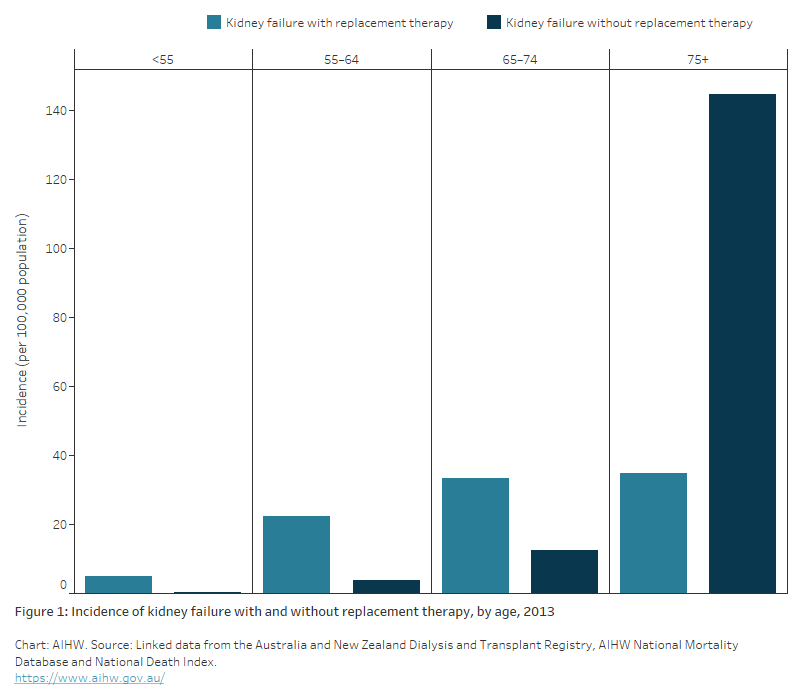
Incidence of kidney replacement therapy
An estimate of the incidence of KRT can be obtained from the ANZDATA Registry. This registry includes information on people who have had KRT in the form of dialysis or a kidney transplant. It does not contain information on people with kidney failure who do not receive KRT.
Not everyone with kidney failure chooses to receive KRT, opting instead for medical management, with a focus on quality of life and symptom control. Therefore, estimates of the total prevalence of kidney failure need to count cases of people who are receiving KRT and those who are not.
Estimating the true incidence of kidney failure in Australia requires linkage between ANZDATA and the National Death Index. This was most recently performed in 2013 and showed that of the 5,100 new cases of kidney failure in 2013, half (2,500) were not receiving treatment with KRT (AIHW 2016). Work is underway by the AIHW to update this linkage (see Data gaps and opportunities).
The total incidence of kidney failure (treated and untreated) is an indicator in the Australian Health Performance Framework (AIHW 2022).
Variation by age and sex
During 2021, 3,300 people with kidney failure started KRT in Australia, at an average of 9 people per day (ANZDATA 2022). Of these, 67% were aged under 70 and 64% were males.
In 2021, the incidence rate of KRT:
- was 1.8 times as high in males as in females
- increased with age, to be highest among men aged 75–79 and women aged 70–74 (Figure 2).
Figure 2: Incidence of kidney replacement therapy, by age and sex, 2021
The bar chart shows the number of new cases of kidney failure with replacement therapy, by age group and sex, for 2021. Males commenced KRT in 2021 at higher rates than females. For both sexes, the number of new cases of kidney failure with replacement therapy peaked in the 75-79 year age group.
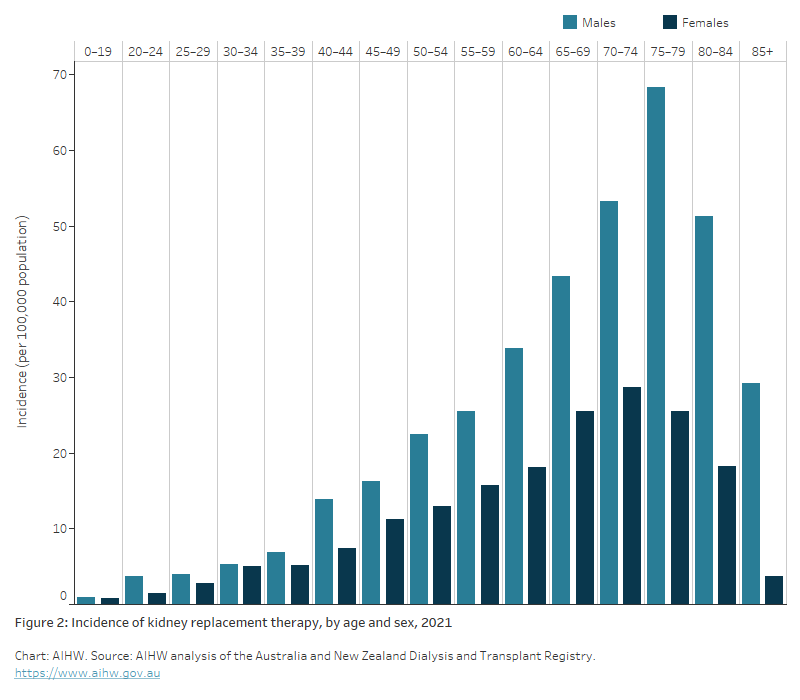
Variation between population groups
Aboriginal and Torres Strait Islander people
Around 1,800 Aboriginal and Torres Strait Islander people living with kidney failure started KRT from 2017 to 2021, a rate of 42 per 100,000 population.
After adjusting for differences in the age structure of the populations:
- the incidence rate of KRT among Indigenous Australians was 6.2 times as high as that for non-Indigenous Australians
- Indigenous females started KRT at a rate 9.4 times as high as that for non‑Indigenous females
- Indigenous males started KRT at a rate 4.4 times as high as that for non-Indigenous males (Figure 3).
Treatment on Country
Treating and managing kidney failure among Indigenous Australians can be challenging, often due to difficulties associated with providing holistic health care that meets the medical, social and cultural needs of clients (Hughes et al. 2019).
Indigenous Australians may also have to leave their home, families and Country to access in-centre haemodialysis, adding to the challenges of treatment (Anderson et al. 2012). Providing dialysis services in remote regions of Australia has enabled more people to access care close to home. Between 2009 and 2016, there was a 42% increase in dialysis treatments delivered in Central Australia (Gorham et al. 2016).
In 2020, 26% of Indigenous Australians who received KRT (including kidney transplantation) did so close to home, with a large increase in the prevalence of peritoneal dialysis in the Northern Territory (ANZDATA 2021). In Central Australia, survival rates for haemodialysis are now higher than for the rest of Australia, going from the worst to the best in the country over the last 20 years (Gorham et al. 2016; UNE 2020).
Community-led services are making it easier for people to access care in their Country. Purple House is an Indigenous owned health service, providing remote dialysis, social support, aged care and National Disability Insurance Scheme services. It operates 18 dialysis units in Central Australia (Purple House 2022).
Remoteness and socioeconomic area
Data for 2017–2021 show that the incidence rate of KRT was much higher in Remote and very remote areas and increased with socioeconomic disadvantage.
After adjusting for differences in the age structure of the populations, rates were:
- 3.7 times as high in Remote and very remote areas as in Major cities. Rates were 6.7 times as high among females, but only 2.2 times as high among males
- 1.8 times as high in the lowest socioeconomic areas as in the highest socioeconomic areas (Figure 3).
Figure 3: Incidence of kidney replacement therapy, by population group, 2017–2021
The bar chart shows rates of new cases of kidney failure with replacement therapy by sex based on Aboriginal and Torres Strait Islander status, remoteness area and socioeconomic area. Indigenous people had commenced replacement therapy for kidney failure at rates 6.2 times higher than non-Indigenous people. Incidence rates for commencing KRT varied across remoteness areas, with the highest rates seen in Remote and Very remote areas, followed by Outer regional. Incidence rates increased by socioeconomic area, with people living in the least disadvantaged socioeconomic areas having the lowest incidence of kidney failure with replacement therapy, and those living in the most disadvantaged areas having the highest. Males commenced KRT for kidney failure at higher rates than females across all measures except for Indigenous females and females living in Remote and Very remote areas.
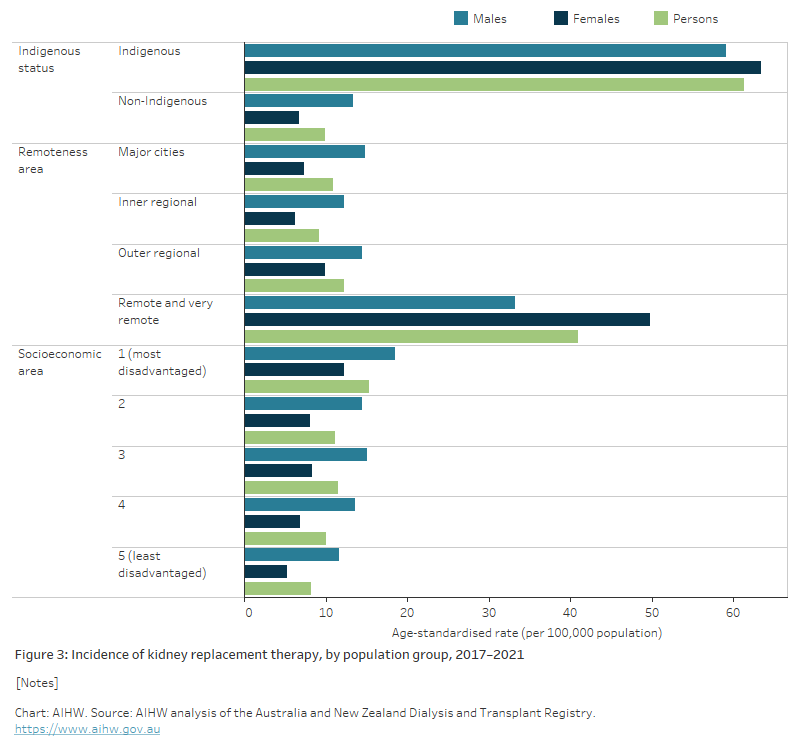
Trends over time
Between 2000 and 2021:
- the number of people with kidney failure who started KRT rose from 1,800 to 3,300
- the age-standardised incidence rate of KRT among males was 1.4 times as high as for females in 2000, increasing to 1.8 times as high in 2021 (Figure 4).
Figure 4: Trends in the incidence of kidney replacement therapy, by sex, 2000 to 2021
The line chart shows the age-standardised trend in the incidence of kidney failure with replacement therapy, from 2000 to 2021, by sex. The incidence rate has remained stable for females over this time, and has increased by one third for males, from 11 cases per 100,000 population in 2000 to 14.6 in 2021.
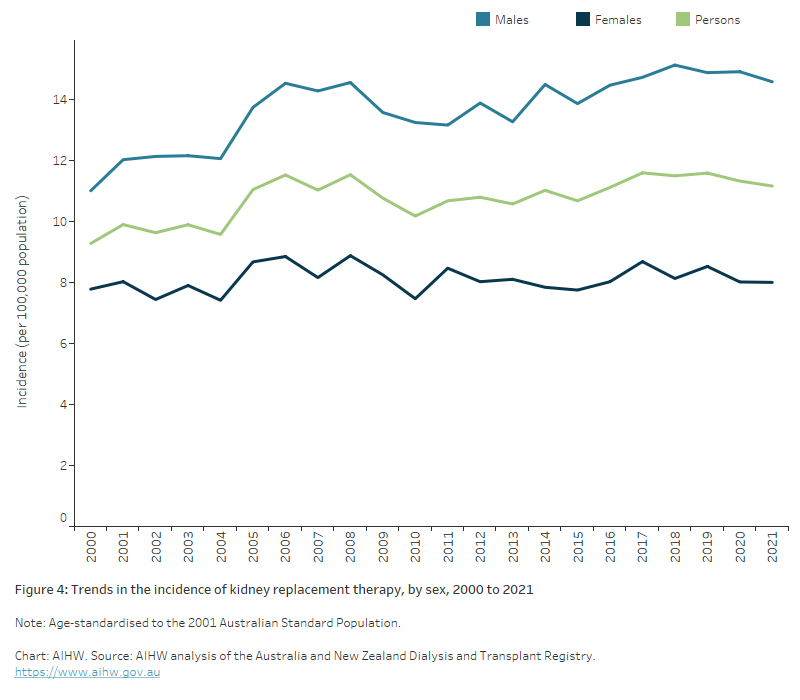
Prevalence of kidney replacement therapy
This section reports on the total number of people with kidney failure who received kidney replacement therapy (KRT) in Australia.
Variation by age and sex
At the end of 2021, 28,500 people living with kidney failure had received KRT in Australia, of whom 61% (17,500) were males, and 71% (20,200) were aged under 70 (ANZDATA 2022).
In 2021, the prevalence rate of KRT:
- was 1.7 times as high in males as in females
- increased with age, to be highest among men aged 75–79 (411 per 100,000 population) and women aged 65–69 (218 per 100,000 population) (Figure 5).
Figure 5: Prevalence of kidney replacement therapy, by age and sex, 2021
The bar chart shows the total prevalence rate of kidney failure with replacement therapy by age and sex in 2021. Across all ages, more males than females were receiving KRT. The overall prevalence increased with increasing age until age 80 to 84.
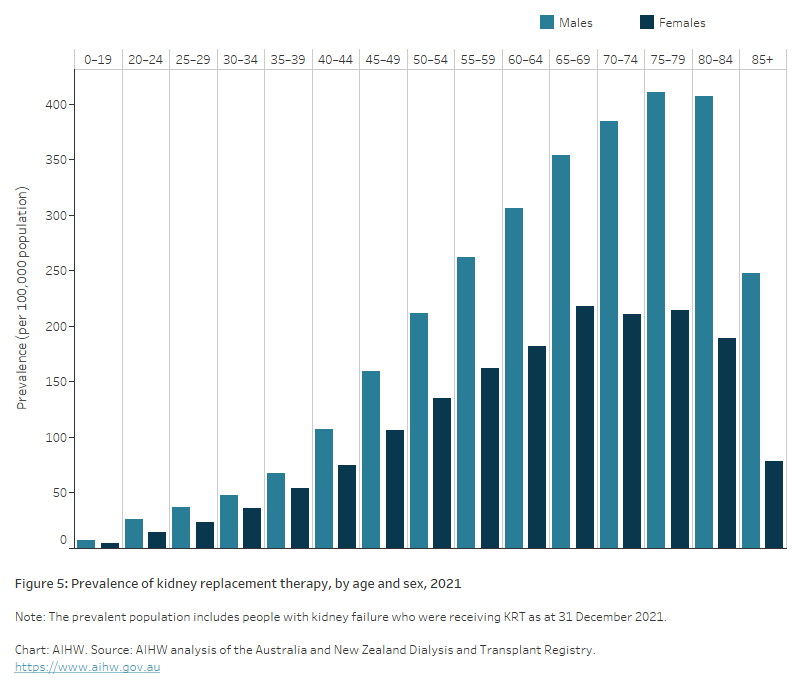
Type of kidney replacement therapy
The type of KRT received varies according to age. In 2021, people with kidney failure aged under 55 were more likely to have a functioning kidney transplant than undergo dialysis (Figure 6).
Between ages 55 and 64, approximately half of the people receiving KRT had a functioning kidney transplant (52%), and half received dialysis (48%).
After age 65, people with kidney failure were more likely to receive dialysis than have a functioning kidney transplant, with the proportion of people on dialysis rising sharply from age 75.
Figure 6: Proportion of kidney replacement therapy type, by age, 2021
The bar chart shows the total prevalence of kidney failure with replacement therapy by age and type of KRT (dialysis or transplant). The general pattern shows that the percentage of people treated with a transplant decreases with age, while dialysis increases. Transplants were the most common for of KRT for those aged 0 to 64, with those aged 0 to 24 having the highest proportion of treatment with transplants (73%). Dialysis was the most common form of KRT in those aged 65 and over, increasing with age. 92% of those aged 85+ receiving KRT were treated with dialysis. For those aged 55 to 64, the prevalence of dialysis and transplants was similar (48% and 52%, respectively).
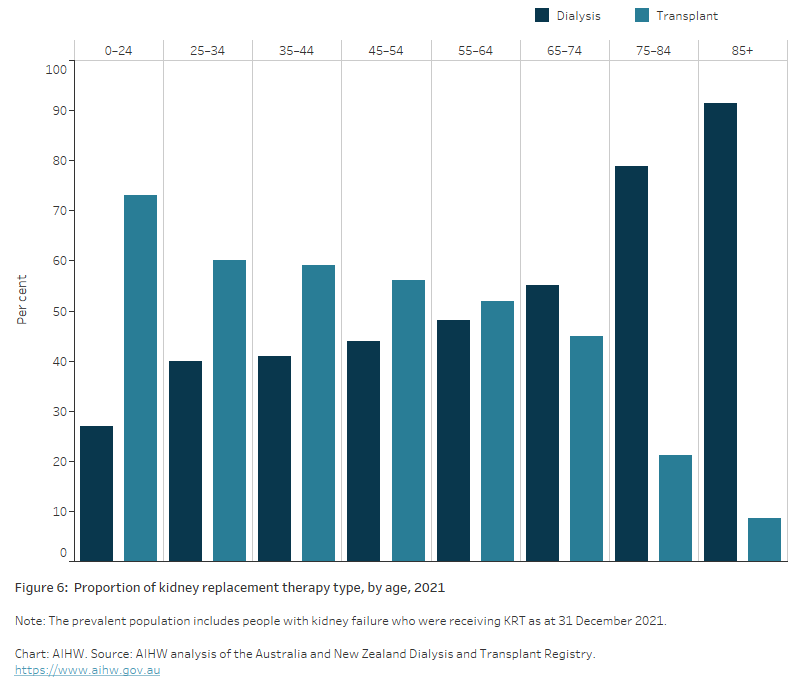
Variation between population groups
Aboriginal and Torres Strait Islander people
Indigenous Australians with kidney failure are more likely to receive dialysis than a kidney transplant, while non-Indigenous Australians with kidney failure are equally likely to receive either KRT type (Figure 7).
In 2021, 2,600 Indigenous Australians with kidney failure received KRT, with 85% undergoing dialysis and 15% having a kidney transplant.
In comparison, 51% of non-Indigenous Australians with kidney failure received dialysis and 49% had a kidney transplant.
Figure 7: Proportion of kidney replacement therapy type, by Indigenous status, 2000 to 2021
The line chart shows the trend in the proportion of Indigenous and non-Indigenous people receiving kidney replacement therapy in the form of either dialysis or transplant. Trends for Indigenous people show little change over the period – in 2021, 85% of Indigenous people with kidney failure underwent dialysis and 15% had a kidney transplant. In comparison, 51% of non-Indigenous Australians with kidney failure received dialysis and 49% had a kidney transplant.
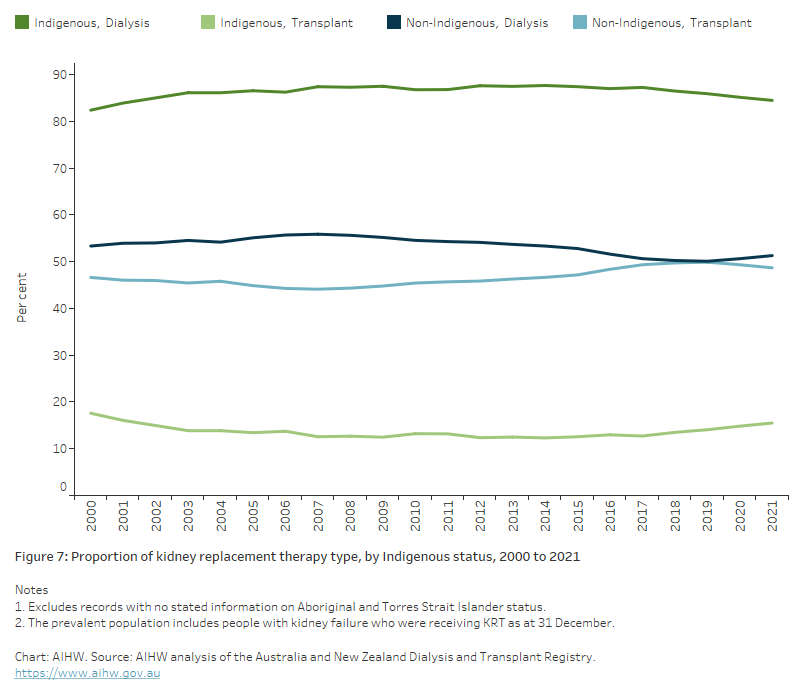
Around 2,600 Indigenous Australians with kidney failure received KRT in 2021, at a rate of 289 per 100,000 population.
After adjusting for differences in the age structure of the populations:
- the prevalence rate of KRT among Indigenous Australians was 5.0 times as high as that for non-Indigenous Australians
- Indigenous females received KRT at a rate that was 7.2 times as high as that for non‑Indigenous females
- Indigenous males received KRT at a rate that was 3.7 times as high as that for non‑Indigenous males (Figure 8).
Remoteness and socioeconomic area
Data for 2021 show that the prevalence rate of KRT was highest in Remote and very remote areas and increased with socioeconomic disadvantage.
After adjusting for differences in the age structure of the populations, rates were:
- 2.8 times as high in Remote and very remote areas as in Major cities. Rates were 4.6 times as high for females and 1.8 as high for males
- 1.6 times as high in the lowest socioeconomic areas as in the highest socioeconomic areas (Figure 8).
Figure 8: Prevalence of kidney replacement therapy, by population group and sex, 2021
The bar chart shows rates of kidney failure with replacement therapy by sex based on Aboriginal and Torres Strait Islander status, remoteness area and socioeconomic area. Indigenous people received replacement therapy for kidney failure at a rate 5.0 times as high as non-Indigenous people. Prevalence rates for KRT were similar across remoteness areas, with the exception of Remote and Very remote areas, which had a rate 2.8 times as high as in Major cities. Prevalence rates increased by socioeconomic area, with people living in the least disadvantaged socioeconomic areas having the lowest prevalence of kidney failure with replacement therapy, and those living in the most disadvantaged areas having the highest. Males received KRT for kidney failure at higher rates than females across all measures except for Indigenous females and females living in Remote and very remote areas.
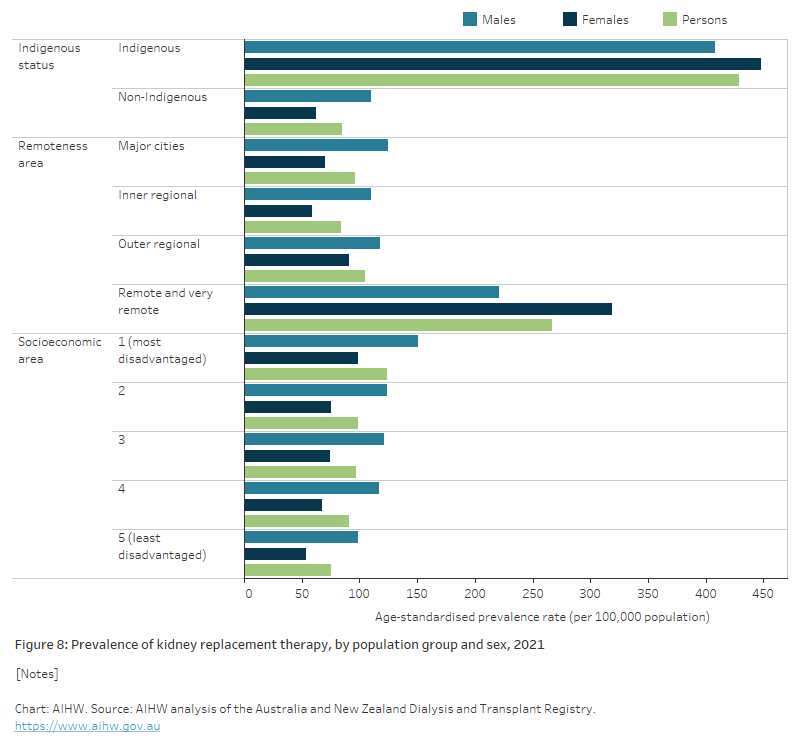
Trends over time
Between 2000 and 2021:
- the number of people with kidney failure receiving KRT more than doubled, from 11,700 to 28,500
- the age-standardised prevalence rate of KRT increased by 57% (Figure 9)
- the age-standardised prevalence rate of KRT among males compared with females increased from 1.4 times as high to 1.7 times as high.
People with kidney failure receiving KRT are about equally likely to receive dialysis or a kidney transplant (Figure 9(b)). Dialysis was slightly more common than kidney transplantation in 2021 (53% and 47%), with the largest difference in the 2 types seen between 2005 and 2010.
Figure 9 and 9(b): Trends in prevalence of kidney replacement therapy, by sex and type, 2000 to 2021
The first line chart shows the age-standardised prevalence rate of kidney failure with replacement therapy, by sex, from 2000 to 2021. The prevalence increased for males and females, growing by 68% for males from 73 to 122 per 100,000 population, and 44% for females from 51 to 74 per 100,000 population.
The second line chart shows the proportions of kidney failure with replacement therapy, by the type of KRT, from 1989 to 2021. In 1989, transplants were the most common form of KRT (53%), in 1994 transplant and dialysis proportions were the same (50%), whereas in 2021, dialysis was the most common form of KRT (53%).
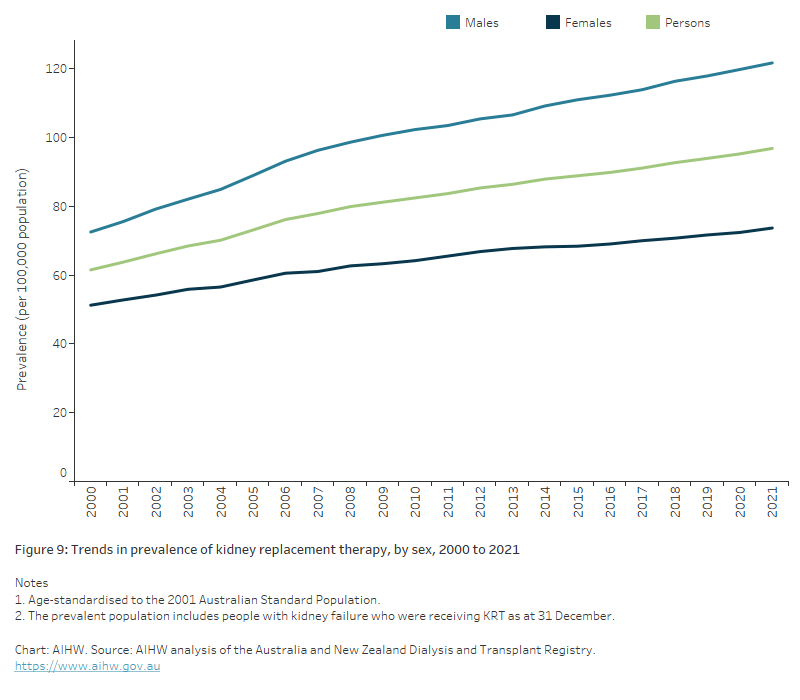
Further information
For more information on KRT in Indigenous people, see:
AIHW (Australian Institute of Health and Welfare) (2016) Incidence of end-stage kidney disease in Australia 1997–2013, AIHW, Australian Government, accessed 8 March 2022.
AIHW (2022) Australia’s health performance framework, AIHW, Australian Government, accessed 8 March 2022.
Anderson K, Cunningham J, Devitt J, Preece C and Cass A (2012) “Looking back to my family”: Indigenous Australian patients’ experience of hemodialysis. BMC Nephrology, 13:114, doi:10.1186/1471-2369-13-114.
ANZDATA (Australia and New Zealand Dialysis and Transplant Registry) (2022) ANZDATA 45th Annual Report 2022, ANZDATA website, accessed 15 March 2023.
Gorham G, Cass A, Howard K and Evans K (2016) Central Australia Renal Study: technical report update, report prepared by the Menzies School of Health Research to the Department of Health, accessed 27 May 2022.
Hughes J, Freeman N, Beaton B, Puruntatemeri M, Hausin M, Tipiloura G et al. (2019) My experiences with kidney care: a qualitative study of adults in the Northern Territory of Australia living with chronic kidney disease, dialysis and transplantation, PLOS ONE 14(12):e0225722. doi:10.1371/journal.pone.0225722.
Purple House (2022) Our story, Purple House website, accessed 21 February 2022.
Sparke C, Moon L, Green F, Mathew T, Cass A, Chadban S et al. (2013) Estimating the total incidence of kidney failure in Australia including individuals who are not treated by dialysis or transplantation, American Journal of Kidney Diseases 61:413–9. doi: 10.1053/j.ajkd.2012.10.012.
UNE (University of New England) (2020) Home-grown Indigenous healthcare – The Purple House, UNE website, accessed 21 February 2022.
WHO (World Health Organization) (2022) Palliative care, WHO, accessed 21 February 2022.


